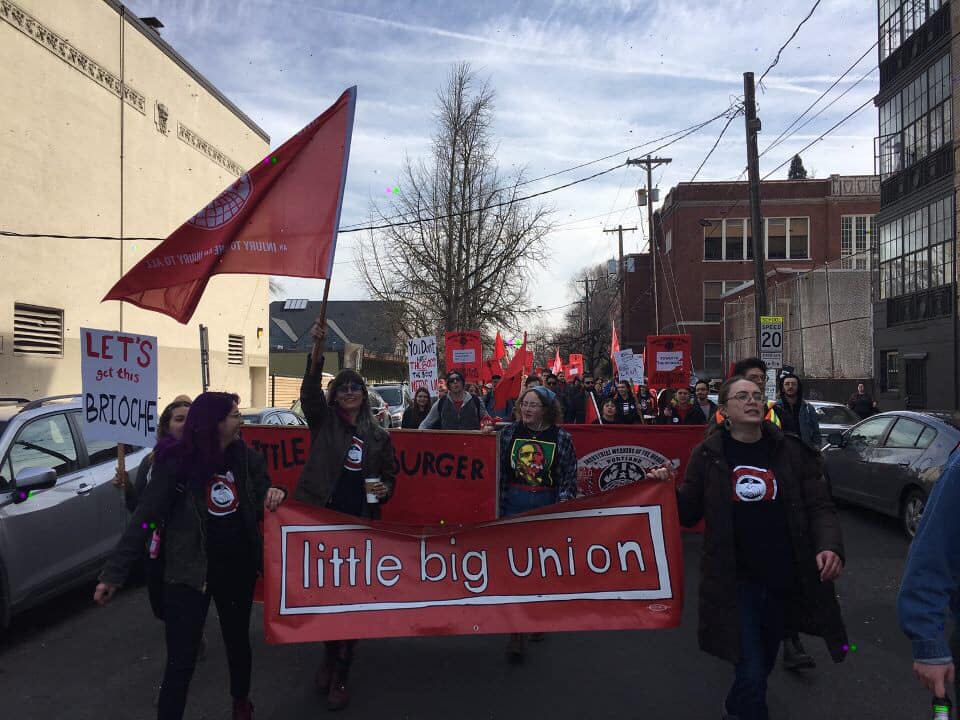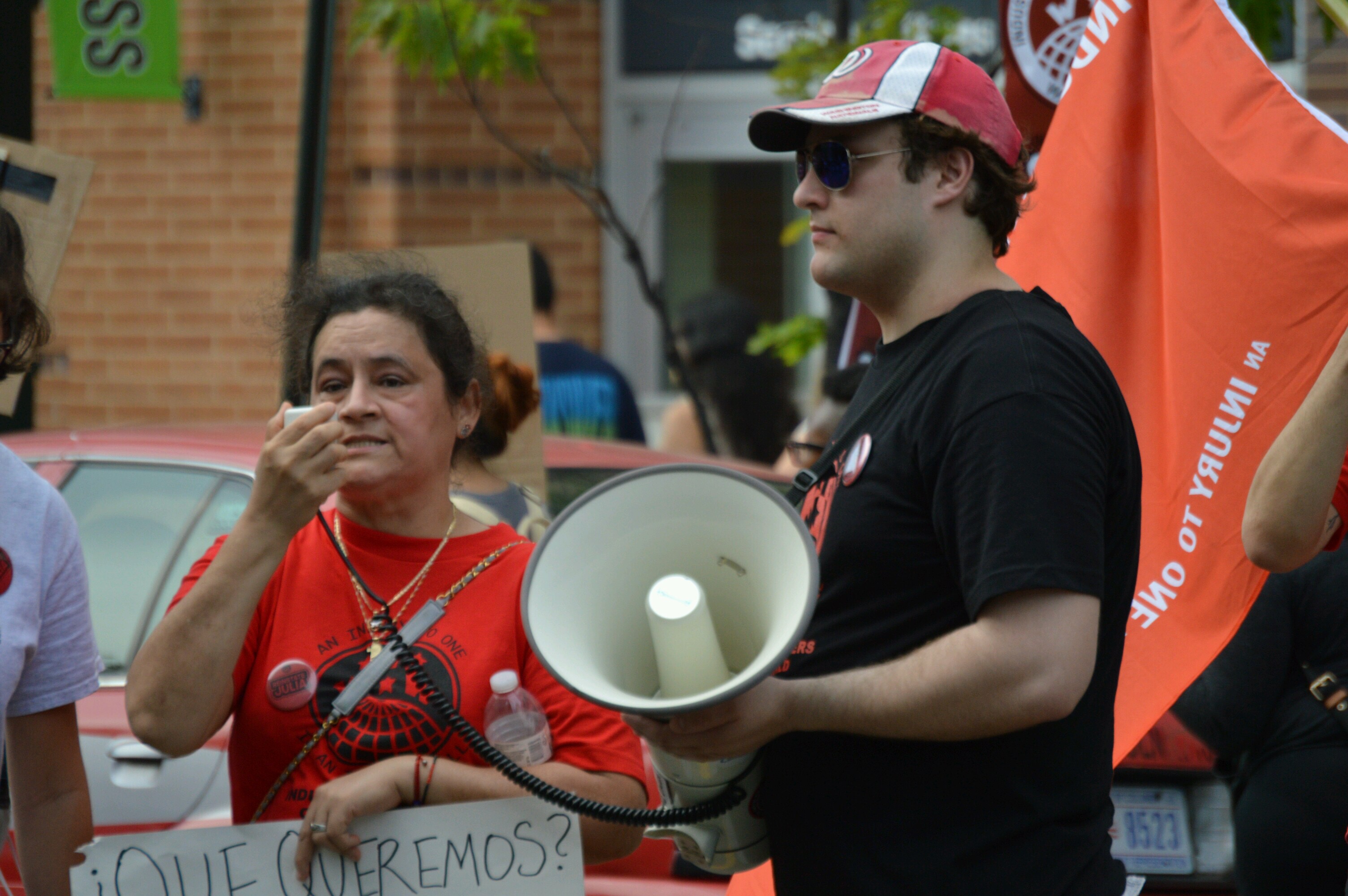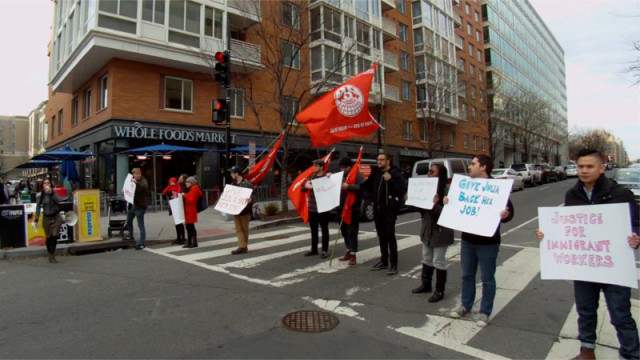Submitted on Wed, 10/26/2016 - 8:35pm
By Arun Gupta - In These Times, October 25, 2016
 Last year, at age 17, Eli Fishel moved out of her parents’ house in Vancouver, Washington, squeezing into a three-bedroom apartment with five other roommates. To pay her bills as she finished high school, Fishel landed a job at Burgerville, a fast-food chain with 42 outlets and more than 1,500 employees in the Pacific Northwest.
Last year, at age 17, Eli Fishel moved out of her parents’ house in Vancouver, Washington, squeezing into a three-bedroom apartment with five other roommates. To pay her bills as she finished high school, Fishel landed a job at Burgerville, a fast-food chain with 42 outlets and more than 1,500 employees in the Pacific Northwest.
Founded in 1961, Burgerville has cultivated a loyal following by emphasizing fresh, local food, combined with sustainable business practices like renewable energy and recycling. But Fishel quickly realized she wasn’t part of Burgerville’s commitment to “regional vitality” and “future generations.”
After 16 months on the job, she earns just $9.85 an hour, barely above the Washington State minimum wage. Her hours and shifts fluctuate weekly, with only a few days’ notice, and every month she goes hungry because she runs out of money to buy food.
Speaking of the privately-owned Burgerville, Fishel says, “We’re poor because they’re rich, and they’re rich because we’re poor.”
Disgruntled Burgerville workers began covertly organizing in 2015. The Burgerville Workers Union (BVWU) went public on April 26 with a march of more than 100 people through Portland, Oregon, and the delivery of a letter to the corporate headquarters in Vancouver. BVWU demands include a $5-an-hour raise for all hourly workers, recognition of a workers organization, affordable, quality healthcare, a safe and healthy workplace, and fair and consistent scheduling with ample notice.
Some BVWU members call their effort “Fight for $15, 2.0,” playing off the name of the fast-food worker campaign launched in 2011 by the Service Employees International Union (SEIU).
SEIU has won plaudits for making the plight of low-wage workers a national issue and igniting the movement for new laws boosting the minimum wage to $15 an hour. But the campaign has not, thus far, included efforts to unionize individual workplaces.
Unlike Fight for $15, which Middlebury College sociology professor and labor expert Jamie McCallum describes as “a fairly top-down campaign,” BVWU is a worker-initiated and -led project backed by numerous labor organizations. The group of Burgerville workers who came up with the idea includes members of Industrial Workers of the World (IWW), a militant union with West Coast roots that date back to the early 1900s. The campaign has the backing of the Portland chapter of IWW and the support SEIU Local 49, the Portland Association of Teachers, and Jobs with Justice.
This scrappy approach enabled BVWU to leapfrog Fight for $15 by declaring a union from the start. While BVWU has not yet formally petitioned for recognition and Burgerville has not chosen to voluntarily negotiate with it, the union has established worker committees in five stores, is developing units in a similar number of shops and counts scores of workers as members.
BVWU is full of lessons in how organizing works. One member likens the campaign to “low-level guerrilla warfare” with workers maneuvering to increase their ranks, build power on the shop floor, expand the terrain from shop to shop, while skirmishing with managers over the work process, and suffering casualties as some members have quit or say they were pushed out of their jobs at Burgerville. In the workplace, the strategy is to develop leaders, form committees for each store, and nurture trust and respect between workers. Outside, BVWU uses direct action to empower workers and bring suppliers into the conversation. The union also works to build community support by mobilizing social-justice groups, clergy, and organized labor to win over the public and pressure the company.
McCallum says that BVWU an example of social movement unionism. “It’s about organizing as a class against another class,” he says. “It’s to win demands not just against a single boss or to change a law, but to engage in class struggle.”
 Workers at Little Big Burger know that our safety, well-being, and voices are important. Every single day we serve customers, cook food, bus tables, and wash dishes. We have formed the Little Big Union to ensure Little Big Burger is truly inclusive of our collective voice as workers.
Workers at Little Big Burger know that our safety, well-being, and voices are important. Every single day we serve customers, cook food, bus tables, and wash dishes. We have formed the Little Big Union to ensure Little Big Burger is truly inclusive of our collective voice as workers. On April 30
On April 30 Julia Flores is a 15 year employee of the P St Whole Foods who was fired from her job for organizing workers and informing them about such laws as the minimum wage. On the 13th of January, the IWW escalated the campaign demanding her job back by blocking the streets in front of another Whole Foods in Foggy Bottom.
Julia Flores is a 15 year employee of the P St Whole Foods who was fired from her job for organizing workers and informing them about such laws as the minimum wage. On the 13th of January, the IWW escalated the campaign demanding her job back by blocking the streets in front of another Whole Foods in Foggy Bottom. Last year, at age 17, Eli Fishel moved out of her parents’ house in Vancouver, Washington, squeezing into a three-bedroom apartment with five other roommates. To pay her bills as she finished high school, Fishel landed a job at
Last year, at age 17, Eli Fishel moved out of her parents’ house in Vancouver, Washington, squeezing into a three-bedroom apartment with five other roommates. To pay her bills as she finished high school, Fishel landed a job at